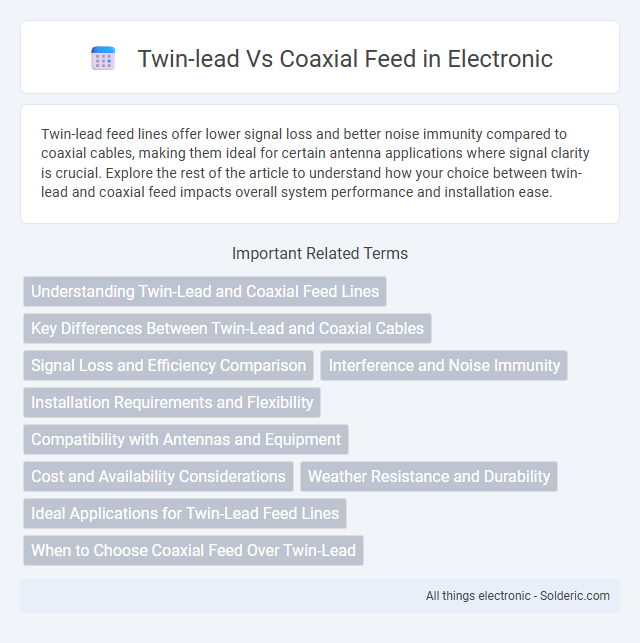Twin-lead feed lines offer lower signal loss and better noise immunity compared to coaxial cables, making them ideal for certain antenna applications where signal clarity is crucial. Explore the rest of the article to understand how your choice between twin-lead and coaxial feed impacts overall system performance and installation ease.
Comparison Table
| Feature | Twin-Lead | Coaxial Feed |
|---|---|---|
| Construction | Two parallel wires separated by a dielectric | Inner conductor, dielectric insulator, outer shield |
| Impedance | Typically 300 O | Typically 50 O or 75 O |
| Shielding | No shielding; susceptible to interference | Outer shield provides excellent EMI protection |
| Signal Loss | Lower loss at HF frequencies | Higher loss at HF, better at UHF and above |
| Installation | Requires spacing from metal objects; bulkier | Compact, flexible, easier to install near metal |
| Cost | Generally lower cost | Generally higher cost |
| Common Uses | AM/FM antennas, HF antenna feedlines | TV cables, internet, UHF/VHF antennas |
Understanding Twin-Lead and Coaxial Feed Lines
Twin-lead feed lines consist of two parallel conductors separated by an insulating material, offering low loss and high impedance ideal for dipole antennas. Coaxial feed lines feature a central conductor surrounded by an insulating layer and a shield, providing superior interference rejection and easier handling in various environments. Choosing between twin-lead and coaxial cables depends on factors like antenna type, signal frequency, and susceptibility to electromagnetic interference.
Key Differences Between Twin-Lead and Coaxial Cables
Twin-lead cables consist of two parallel wires separated by a non-conductive material, offering lower signal loss but higher susceptibility to interference and require precise spacing and grounding. Coaxial cables feature a single conductor surrounded by an insulating layer and a metallic shield, providing superior protection from electromagnetic interference and easier installation with connectors. Choosing the right cable for your antenna setup depends on balancing signal quality, ease of use, and environmental factors.
Signal Loss and Efficiency Comparison
Twin-lead feed exhibits lower signal loss compared to coaxial cable due to its balanced design and lower resistance, enhancing overall transmission efficiency for your antenna system. Coaxial cable, while more susceptible to higher signal attenuation especially over long distances, offers superior shielding against electromagnetic interference. For maximizing signal strength and minimizing loss, selecting twin-lead is often more efficient in low-noise environments.
Interference and Noise Immunity
Twin-lead cable offers superior noise immunity due to its balanced transmission line design, which effectively rejects electromagnetic interference (EMI) by utilizing equal and opposite currents on its two conductors. Coaxial cable, with its unbalanced design and single central conductor surrounded by a shield, provides good shielding against external noise but can be more susceptible to interference if the shield is damaged or improperly grounded. In high-interference environments, twin-lead's balanced nature often results in better noise rejection, while coaxial feed excels in physical durability and ease of installation.
Installation Requirements and Flexibility
Twin-lead feed cables require careful spacing from conductive materials and must be supported to maintain consistent spacing between the two wires, making installation more sensitive and limited in confined spaces. Coaxial cables offer greater installation flexibility due to their shielded design, allowing them to be routed near metal structures without significant signal loss or interference. The ease of bending and securing coaxial cables often results in more straightforward and adaptable installations, especially in complex or tight environments.
Compatibility with Antennas and Equipment
Twin-lead feed lines offer excellent compatibility with dipole and certain balanced antennas due to their balanced transmission lines, minimizing interference and signal loss. Coaxial cables provide broader compatibility with most modern antennas and radio equipment thanks to their unbalanced design and shielding, which reduces noise and is typically easier to connect with standard connectors like PL-259 or N-type. Your choice between twin-lead and coaxial should consider the specific antenna type and equipment requirements to ensure optimal signal quality and system performance.
Cost and Availability Considerations
Twin-lead cables typically offer a lower-cost alternative to coaxial cables, making them appealing for budget-conscious antenna installations. Availability of twin-lead cables can be limited compared to the widespread accessibility of various types and brands of coaxial cables. Your choice should consider not only upfront cost but also ease of sourcing the right cable type for your specific application.
Weather Resistance and Durability
Twin-lead feed lines offer moderate weather resistance but are more susceptible to moisture absorption, leading to potential signal degradation and corrosion over time. Coaxial cables feature a robust outer jacket and shielding that provide superior durability and protection against rain, UV exposure, and temperature fluctuations, ensuring consistent performance in harsh weather conditions. For your antenna setup in challenging environments, coaxial feed lines generally deliver longer-lasting reliability and reduced maintenance.
Ideal Applications for Twin-Lead Feed Lines
Twin-lead feed lines excel in applications requiring low-loss performance over moderate distances, especially in HF and VHF antenna systems. Their balanced design minimizes interference and signal distortion, making them ideal for use with balanced antennas such as dipoles. You benefit from their lightweight construction and cost-effectiveness when setting up amateur radio, shortwave listening, or television antennas in low-noise environments.
When to Choose Coaxial Feed Over Twin-Lead
Choose coaxial feed over twin-lead when signal interference and noise immunity are critical factors, as coaxial cable offers better shielding against electromagnetic interference. Coaxial cables also provide more reliable performance over longer distances and in outdoor installations, thanks to their robust construction and weather resistance. Your antenna system benefits from easier grounding and compatibility with most modern radio equipment when using coaxial feed.
twin-lead vs coaxial feed Infographic

 solderic.com
solderic.com